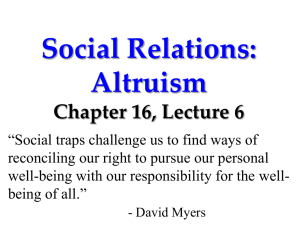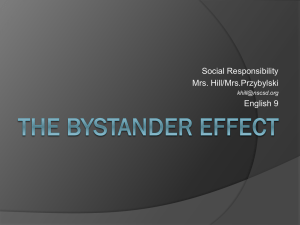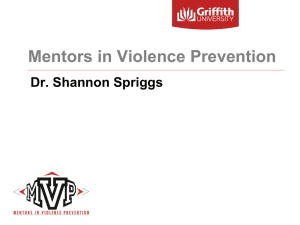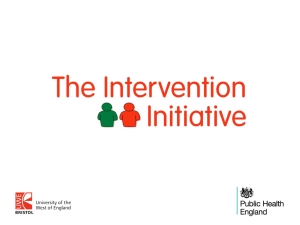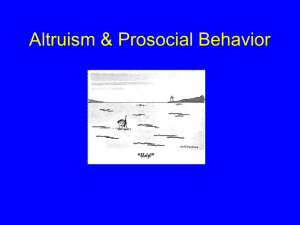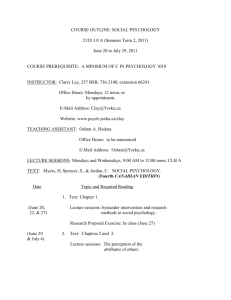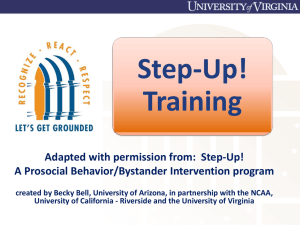(helping) Behavior - psychinfinity.com
advertisement
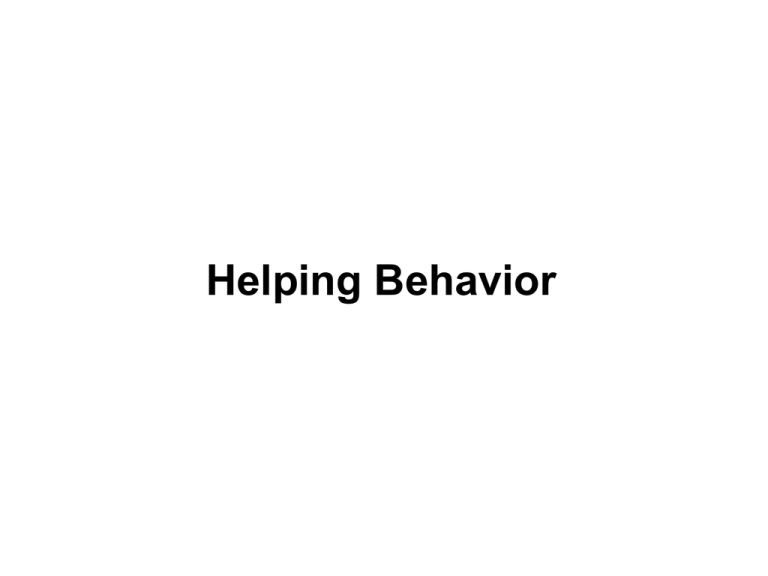
Helping Behavior I. Helping Behavior Defined A. Prosocial (helping) Behavior: any voluntary behavior intended to help others. 1) Altruism: behavior intended to help others out of inner concern for the welfare of others and without conscious regard for one’s self-interests. 2) Egoism: consciously planned behavior that involves helping others as a means to benefit oneself. II. Why and When Do We Help?... The Individual Perspective A. Social Exchange Theory: the theory that human interactions are transactions that aim to maximize one’s rewards and minimize one’s costs. B. External Rewards C. Internal Rewards 1) Empathy-Altruism Hypothesis: the idea that when we feel empathy for a person (the ability to put oneself in the shoes of another person and to experience events and emotions the way that person experiences them), we will attempt to help that person purely for altruistic reasons, regardless of what we have to gain. 2) Negative-State Relief Hypothesis: the idea that instead of helping because we genuinely care about the welfare of another person, we help because such actions allow us to reduce our own distressful, unpleasant emotions. 3) Empathic-Joy Hypothesis: the idea that helpers respond to the needs of a victim because they want to accomplish something and doing so is rewarding in and of itself. 4) Feel Bad Do Good Feel Good… Reducing Guilt 5) Feel Good Do Good… Sustaining a Positive Mood D. Social Norms 1) The Norm of Reciprocity: the expectation that people will help, not hurt, those who have helped them. 2) The Social-Responsibility Norm: the expectation that people will help those in need of help. E. Evolutionary Theory (Kin Selection): the idea that evolution has selected altruism toward one’s close relatives to enhance the survival of mutually shared genes. III. Why and When Do We Help?... The Situational Perspective A. The Murder of Kitty Genovese B. The Bystander Effect: people are less likely to offer help in an emergency situation when other people are present; the greater the number of bystanders, the less likely it is that any one of them will help. C. Using Gestalt Psychology to explain the Bystander Effect in emergency situations. 1) Gestalt Psychology: focuses on the human ability to perceive overall patterns. 2) Figure and Ground: what’s the object of focus and what’s the background. 3) In large crowds, a person’s attention is focused mostly on the victim, who is figural, and less so on themselves. Therefore, they see themselves as part of the background, which reduces the likelihood that they will offer assistance. 4) In instances when a person is the only bystander, they are equally figural relative to the person in trouble which draws their attention to the fact that they are the only person capable of offering assistance. 5) Objective Self-Awareness Theory: argues that when a bystander’s attention is focused on themselves, standards of appropriate behavior (the social norms of helping) get activated. This increases the likelihood that the bystander will offer help as attention shifts back and forth between themselves (helper) and the victim. D. Latené and Darley’s Five Step Model Leading to Helping 1) Noticing the Event 2) Interpreting the Event Pluralistic Ignorance: people will sometimes assume that with ambiguous information or in the absence of information that others have a different and better-informed opinion. 3) Assuming Responsibility Diffusion of Responsibility: we tend to feel less responsibility to act when other people nearby are equally able to act. 4) Knowing How to Offer Help 5) Deciding to Help E. Monkey See, Monkey Do… Again 1) Once we see some people helping, other people begin helping. In fact, too many people may try to offer help and cause “helping interference”. 2) Key Explanations… The Event Gets Noticed Objective Self-Awareness Increases Reduction of Pluralistic Ignorance By observing other helpers, you now know how to help. Fear and embarrassment of acting is reduced. Conformity F. The Perceived Responsibility Models of Helping 1) The Moral Model: people are held responsible both for problems and solutions and are believed to need proper motivation. 2) The Compensatory Model: people are not seen as responsible for problems but they are responsible for solutions. 3) The Medical Model: people are seen as neither responsible for the problem nor for the solution. 4) The Enlightenment Model: people are seen as responsible for problems but as unable or unwilling to provide solutions. G. Time Pressures H. Good Samaritan Laws I. Environmental Factors 1) People are more helpful when it’s pleasantly warm and sunny. 2) People are more likely to help strangers in small towns & cities than in big cities. 3) What matters is the current environmental setting, not where a person was raised. 4) Urban Overload Hypothesis: the theory that people living in cities are constantly being bombarded with stimulation and that they keep to themselves to avoid being overwhelmed by it. J. Similarity 1) We are likely to help people we perceive as similar to us in some way. K. Attractiveness 1) Physically attractive and well-dressed people are more likely to receive help than physically unattractive and poorly-dressed people. 2) This is especially strong when it comes to attractive women receiving help from men. IV. Who Will Help? A. The Altruistic Personality 1) High Levels of Empathy 2) Belief in a Just World 3) Accepting of Social Responsibility 4) An Internal Locus of Control 5) Low Egocentrism B. Gender 1) Men are more likely to engage in helping that is heroic and chivalrous. 2) Men are more likely to help strangers than are women. 3) Women are more likely to engage in helping that is nurturing. C. Religiosity 1) Religious people are more likely to help in numerous ways than are non-religious people. 2) Religion operates similarly to social norms. The norms of many religions include the element of helping those in need. V. Who Wants Help? A. Equity 1) People may prefer relationships which are equitable, in which giving and receiving are in balance. One-way helping threatens equity and creates power imbalances. B. Self-Esteem 1) When aid lowers recipients’ self-esteem, they are more likely to dislike both the aid and the helper, and are likely to avoid seeking such help again. 2) When the helper is very similar to oneself, receiving aid is likely to reduce one’s self-esteem. 3) How recipients respond to help is also influenced by their present level of self-esteem. VI. How Can Helping Behavior be Increased? A. Personalized Verbal Appeals 1) “Even a penny will help.” B. Personalized Nonverbal Appeals C. Learning to be Helpful D. Learning about Helping Behavior E. Devictimize Yourself!
